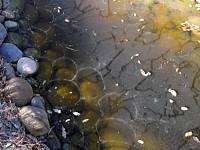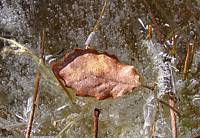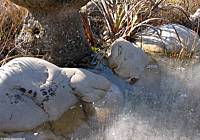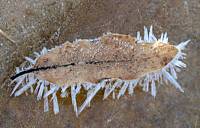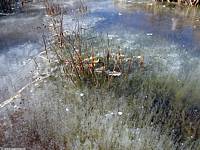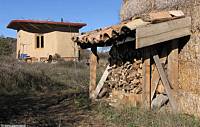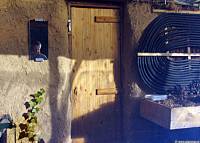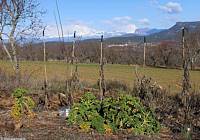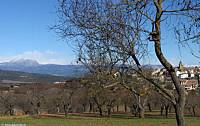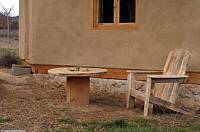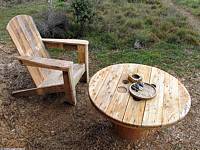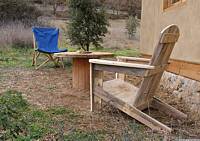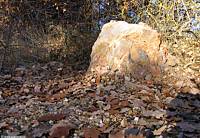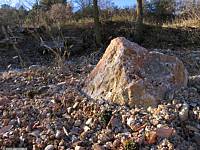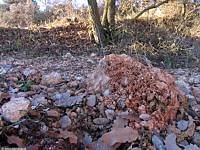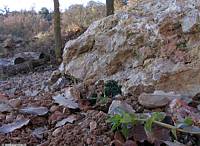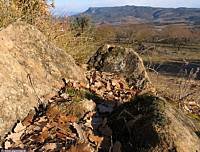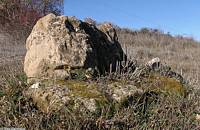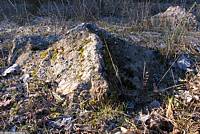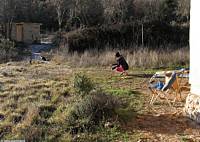|
|
Nature
Switched On
in the Pyrenees the first 10 years |
|
|
|
introduction |
2011 January 15 to 26 With temperatures down to -8ºC in
the early mornings, it is quite cold these days. During our absence
last weekend the water supply to the garden In the image on the right two different patterns can
be seen. The round shapes in the ice correspond clearly to the
stones below and will have been formed in some way by the higher
temperatures of the stone compared with the water. More enigmatic
are the 'writings' in the ice, but I suspect that they are the work
of the Backswimmers (Notonecta) which I had seen active in
previous weeks.
Usually leaves which fall on the ice capture the sun rays, warm up and slowly melt and sink down into the ice. But I observed a Portuguese oak leaf, in a shady area, which went the opposite direction. It is being lifted up by the growing of numerous tiny icicles, probably during several days of continuous frost.
The macro-alga (Chara) in the upper pond seems to continue producing quite some oxygen in mid-winter.
|
|
|
|
A Portuguese oak leaf melting down into the ice of the upper
pond. 26 Jan 12:38 |
|||
|
A kind of dead oak-centipede, moving upwards. 26 Jan 12:40 |
The centipede is to the right of
the centre. 26 Jan 12:36 |
||
|
Air bubbles produced by Chara in the upper pond. 26 Jan 12:33 |
|||
|
The inside climate also gets somewhat severer of course. In the
early morning, when the outside temperature gets below -5ºC, inside
the temperature is around 15º. We have used about half our fire wood
stock and this will probably get us through the winter. In the
greenhouse the temper
|
|||
| We have
burnt one (front) row of the fire wood stock. 21 Jan 11:16 |
The Hedera helix has its roots outside but its leaves take advantage of the milder indoor climate of the solar greenhouse. 15 Jan 10:05 |
||
|
We have stopped feeding sunflower seed to the birds: they managed to consume one packet of 'pipas' a day. In stead we make our own mixture of animal fat, seeds and nuts. It lasts a lot longer and attracts tits, chaffinches and the occasional Red robin or Greenfinch. |
|||
| Some
green kale plants in the vegetable plot. Looking north. 21 Jan 11:19 |
|||
|
Birdfeeder with the fat mixture 21 Jan 13:45 |
|||
|
We were in a bad need for good outdoor furniture and I decided to
pick up an idea from the recommendable English magazine
Permaculture (summer 2010 issue) and make an Adirondack outdoor chair out of salvaged pallets. In stead of giving dimensions and design details, I think three photographs will be sufficient to get the idea and make one yourself.
|
|||
|
Adirondack outdoor chair. Adirondack is the name of the North-American mountain range were the designer Thomas Lee, on holiday, came up with the idea for this chair in 1903. 19 Jan around 14:00 |
The chair has not been stained yet. The table is a partly buried, salvaged reel for electric cable. 19 Jan 14:09 |
||
|
In the rock corner the leaves of the oak trees have covered the
area. Also remarkable is the alteration of the soil by the frost.
Typical for recently moved and bare soil is this upheaval and
granulation of the upper soil layer by the continuous process of
freezing and thawing.
Also some rocks suffer this kind of erosion, when some parts of the
stone are more poriferous and absorb
water which freezes up and expands.
Moss keeps green and active in winter and draws attention especially
on stone.
|
|||
|
Cover of Portuguese oak leaves
in the rock corner. 21 Jan 9:59 |
|||
|
Outcropping soil with some plantings of Sedum and
Sempervivum. 21 Jan 9:54 |
|
||
|
Outcropping soil with Sedum and, in the foreground,
Anagallis arvensis. The rock shows the first signs of lichen growth. 21 Jan 9:50 |
An older part of the rock corner, with Sempervivum tectorum
and flowering moss. |
||
|
I thought that cement blocks were very unwilling to form a substrate
for mosses or lichens but on the 'monument' I
|
|||
|
Stone group in the 'front yard' of the garden house. Looking west. 21 Jan 10:55 |
Stone group on the upper
terrace, installed in April
2007. Looking south-west. 21 Jan 10:31 |
||
|
Cement blocks with moss growth in the lower right corner. The planted Achillea millefolium on the left is also doing well. 21 Jan 10:15 |
|||
|
The flora in the zone offered two nice surprises, also surprisingly similar in character: I discovered two new spontaneous species, both evergreen, and both species I had tried to introduce before by sowing and planting with poor success.
They are Arctostaphylos uva-ursi (Bearberry) and Viburnum
tinus. Both species are not too uncommon in the surrounding
region.
|
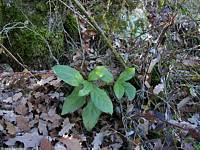
|
Spontaneous Viburnum
tinus in a shady area on the central terrace. 21 Jan 11:22 |
|
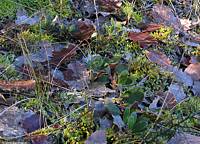 |
Spontaneous Arctostaphylos
uva-ursi in a shady area on the highest terrace. 21 Jan 11:35B |
||
|
|
|||
|
Blanca with 'Camarero' (because of his black and white suit). 15 Jan 10:17 |
|||
|
introduction
|
|
||
